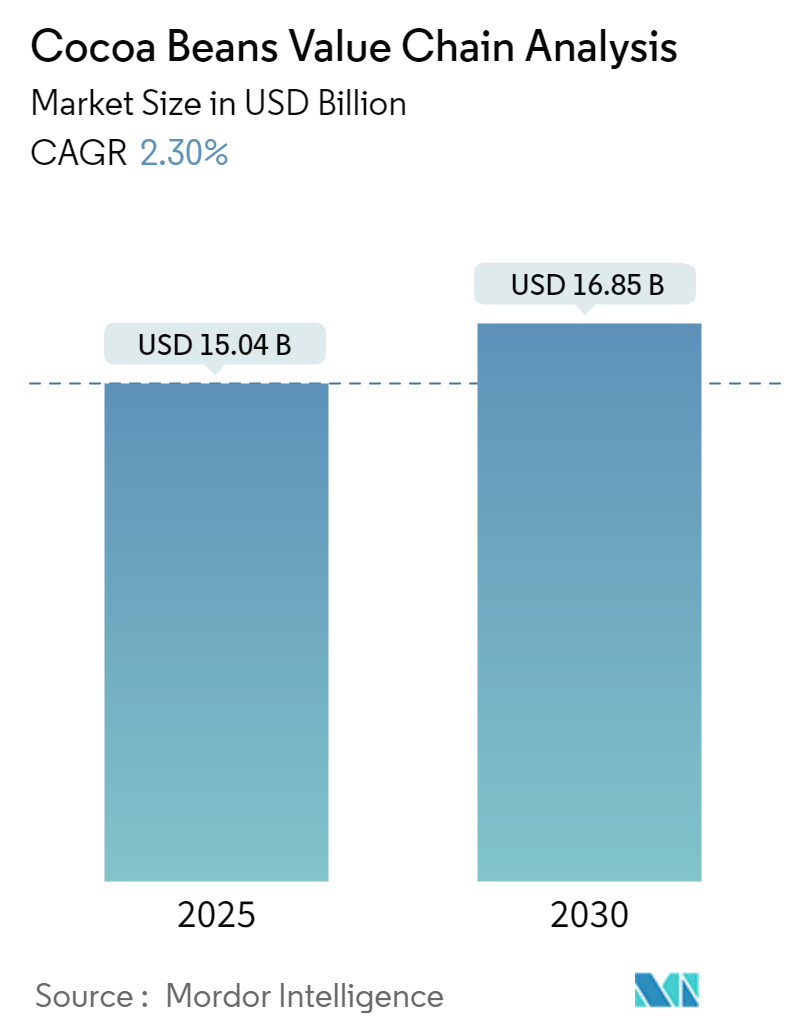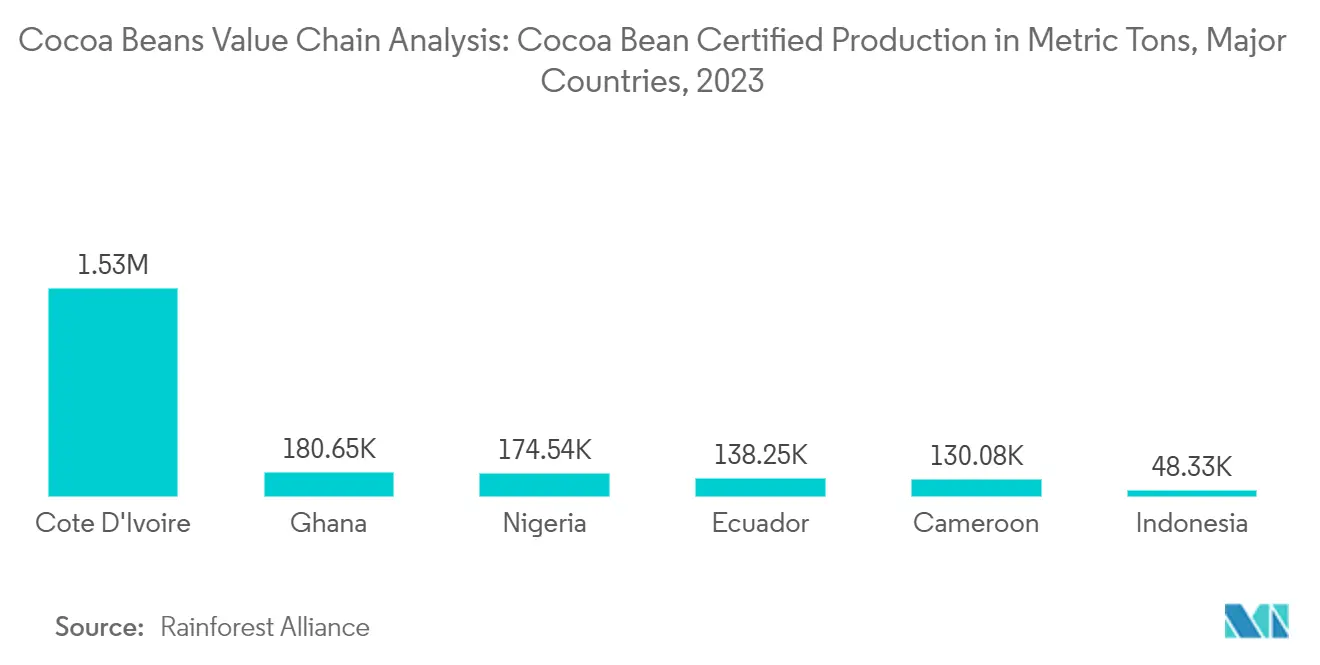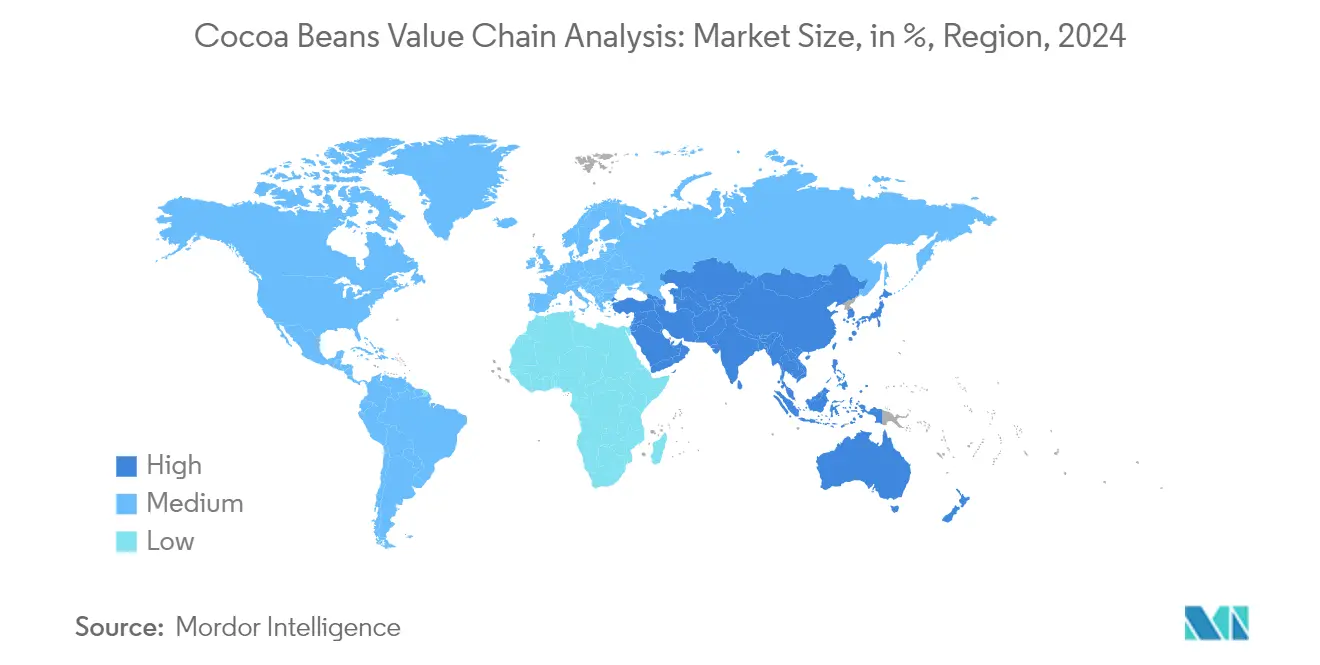Cocoa Beans Value Chain Analysis Market Size
Cocoa Beans Value Chain Analysis Market Analysis
The Cocoa Beans Market size is estimated at USD 15.04 billion in 2025, and is expected to reach USD 16.85 billion by 2030, at a CAGR of 2.30% during the forecast period (2025-2030).
- According to the International Cocoa Organization (2022), cocoa is produced between 10° north and 10° south of the Equator, with the three largest producing countries being Cote d'Ivoire, Ghana, and Ecuador. Africa leads cocoa production worldwide, accounting for 75% of the global output in 2022-2023. Cote d'Ivoire and Ghana are the primary contributors, collectively responsible for over 55% of global production according to the FAOSTAT data. The Netherlands remained the world's leading importer of cocoa beans, importing 770 thousand metric tons in 2023, up from 690 thousand metric tons in 2022. Malaysia followed with 533 thousand metric tons in 2023, as per ITC Trade Map. The Netherlands' position in cocoa imports results from its role as a major chocolate processing and distribution center, with multiple large-scale cocoa processing facilities that convert raw beans into cocoa butter, powder, and chocolate.
- The global cocoa bean market experienced growth from the chocolate industry, primarily due to increased demand for premium, single-origin, and certified chocolates. The 2022 Cocoa Barometer reported that major chocolate manufacturers, including Nestle, Mondelez, Mars, Hershey, Lindt & Sprungli, and Ferrero, consumed over 1.7 million metric tons of cocoa in 2020-2021, representing 40% of global cocoa production during that period.
- The cocoa supply chain operates through multiple channels. Small traders purchase cocoa beans directly from individual farmers. These small buyers then sell to wholesalers, who subsequently supply exporters. Alternatively, farmers' cooperatives sell directly to exporters or handle exports themselves. Despite significant growth in the cocoa sector, supply-side risks may limit industry expansion. The sector faces ongoing challenges, including price volatility and income inequality across the value chain. Addressing these issues requires collaboration among industry stakeholders, including governments, standard-setting bodies, development organizations, and private companies, to ensure equitable distribution of benefits from increasing cocoa demand throughout the value chain.
Cocoa Beans Value Chain Analysis Market Trends
Sustainable Sourcing to Improve Economies for Stakeholders
Cocoa production faces significant sustainability challenges, including forced and child labor, poor working conditions, land rights disputes, and illegal cultivation in protected forests. The industry also confronts complex human rights and environmental issues among smallholder farmers, including poverty, child labor, deforestation, and soil degradation.
In response, industry participants have adopted responsible cocoa-sourcing policies to support farmers through improved productivity, quality enhancement, and better living standards via farming support and education. The main voluntary sustainability standards (VSS) in the cocoa sector include UTZ Certified, Rainforest Alliance, Fairtrade, and Organic certification. In Côte d'Ivoire, these certifications utilize the CCC platform SYDORE for verification of volumes, dates, and transaction details. Rainforest Alliance's 2024 strategic plan aims to expand sustainable cocoa production practices to reach 100 million farmers and workers globally by 2030.
Major companies in the industry have implemented sustainable cocoa-sourcing programs while maintaining quality standards. Nestlé sources sustainable cocoa through partnerships with Rainforest Alliance and other organizations to enhance cocoa farm sustainability. Ferrero achieved 100% sustainable cocoa bean sourcing across its supply chain in April 2021, with emphasis on farmer welfare and sustainable practices. The company sources through certification organizations including Rainforest Alliance (UTZ), Fairtrade, and Cocoa Horizons, utilizing their specific strengths to support its cocoa sustainability strategy.
Concentration in the Global Cocoa Beans Value Chain
Côte D'Ivoire and Ghana dominate global cocoa production. In 2023, Côte D'Ivoire led with a production of 2.38 million metric tons, followed by Ghana at 653.7 thousand metric tons, as per FAOSTAT data. Disruptions in these nations' supply chains could trigger significant cocoa shortages worldwide. The cocoa market's complexity stems from corporations easily accessing resources and achieving economies of scale. This dynamic has spurred both vertical and horizontal integration within the industry. Consequently, a handful of large trading and processing firms now wield considerable influence over both global and local cocoa markets. In 2024, the West African Development Bank (BOAD) extended a short-term loan of about USD 25.5 million to Ivory Cocoa Product (ICP), a key player in Côte D'Ivoire's cocoa processing sector. This funding was earmarked for acquiring 7,500 metric tons of cocoa beans for the 2024-2025 season, bolstering the nation's local processing goals.
Germany stands out not only as a leading cocoa consumer but also as one of the foremost processing nations. Germans, known for their chocolate affinity, boast a per capita consumption of around 9 kg annually, as highlighted by the CBI Ministry of Foreign Affairs in 2021. Hot chocolate, a winter favorite, has seen a surge in demand. Furthermore, the burgeoning trend of plant-based and vegan diets has spurred the use of cocoa in non-dairy chocolate substitutes and snacks. A testament to this trend, Lindt LINDOR rolled out a plant-based variant of its Truffle Balls in the US in April 2024, showcasing Non-Dairy OatMilk and Dark Chocolate OatMilk flavors. The Netherlands, with its processing hubs in Amsterdam and the port of Rotterdam, has cemented its status as a leading global player in cocoa. These facilities, among Europe's largest, adeptly transform vast quantities of cocoa beans into products such as cocoa mass, butter, and powder. Therefore, advancements in cocoa bean farming technology have bolstered efficiency, sustainability, and productivity, propelling the cocoa market's growth during the forecast period.
Cocoa Beans Value Chain Analysis Market News
- September 2024: The Rainforest Alliance has set a target to reach 100 million farmers and workers worldwide by 2030, with an emphasis on sustainable cocoa production and deforestation-free supply chains. The organization conducted a stakeholder workshop in Nigeria to discuss strategies for implementing sustainable practices and ensuring compliance with the EU Deforestation Regulation. Currently, more than 50% of Nigeria's cocoa production meets the Rainforest Alliance sustainable agriculture standard.
- August 2024: The Central Plantation Crops Research Institute (CPCRI) developed and released two new cocoa varieties, VTL CH I and VTL CH II, to enhance cocoa cultivation in India. These varieties contain high fat and nutrient content, with VTL CH II demonstrating resistance to black pod rot.
- October 2024: Guan Chong Berhad (GCB), a Malaysian cocoa producer, inked a deal to acquire a 25% stake in Côte d'Ivoire's Transcao. This move follows GCB's recent launch of a 60,000 metric tons cocoa grinding facility in Côte d'Ivoire, with the intent to bolster local cocoa processing and streamline supply chains.
Cocoa Beans Value Chain Analysis Industry Segmentation
A value chain encompasses sequential steps that transform raw materials into finished products, from initial design through final delivery to customers. Each step adds value through sourcing, manufacturing, and marketing activities. The cocoa industry's value chain consists of five primary segments such as production, sourcing and trading, marketing, processing, and distribution to end consumers through retail channels. The report analyzes the global cocoa industry's supply chain and value chain, including detailed assessments of stakeholder roles, price margins at each level, and challenges within the value chain system.
Cocoa Beans Value Chain Analysis Market Research FAQs
How big is the Cocoa Beans Market?
The Cocoa Beans Market size is expected to reach USD 15.04 billion in 2025 and grow at a CAGR of 2.30% to reach USD 16.85 billion by 2030.
What is the current Cocoa Beans Market size?
In 2025, the Cocoa Beans Market size is expected to reach USD 15.04 billion.
Which is the fastest growing region in Cocoa Beans Market?
Asia-Pacific is estimated to grow at the highest CAGR over the forecast period (2025-2030).
Which region has the biggest share in Cocoa Beans Market?
In 2025, the Europe accounts for the largest market share in Cocoa Beans Market.
What years does this Cocoa Beans Market cover, and what was the market size in 2024?
In 2024, the Cocoa Beans Market size was estimated at USD 14.69 billion. The report covers the Cocoa Beans Market historical market size for years: 2019, 2020, 2021, 2022, 2023 and 2024. The report also forecasts the Cocoa Beans Market size for years: 2025, 2026, 2027, 2028, 2029 and 2030.
Our Best Selling Reports
Cocoa Beans Value Chain Analysis Industry Report
Statistics for the 2025 Cocoa Beans Value Chain Analysis market share, size and revenue growth rate, created by Mordor Intelligence™ Industry Reports. Cocoa Beans Value Chain Analysis analysis includes a market forecast outlook for 2025 to 2030 and historical overview. Get a sample of this industry analysis as a free report PDF download.





